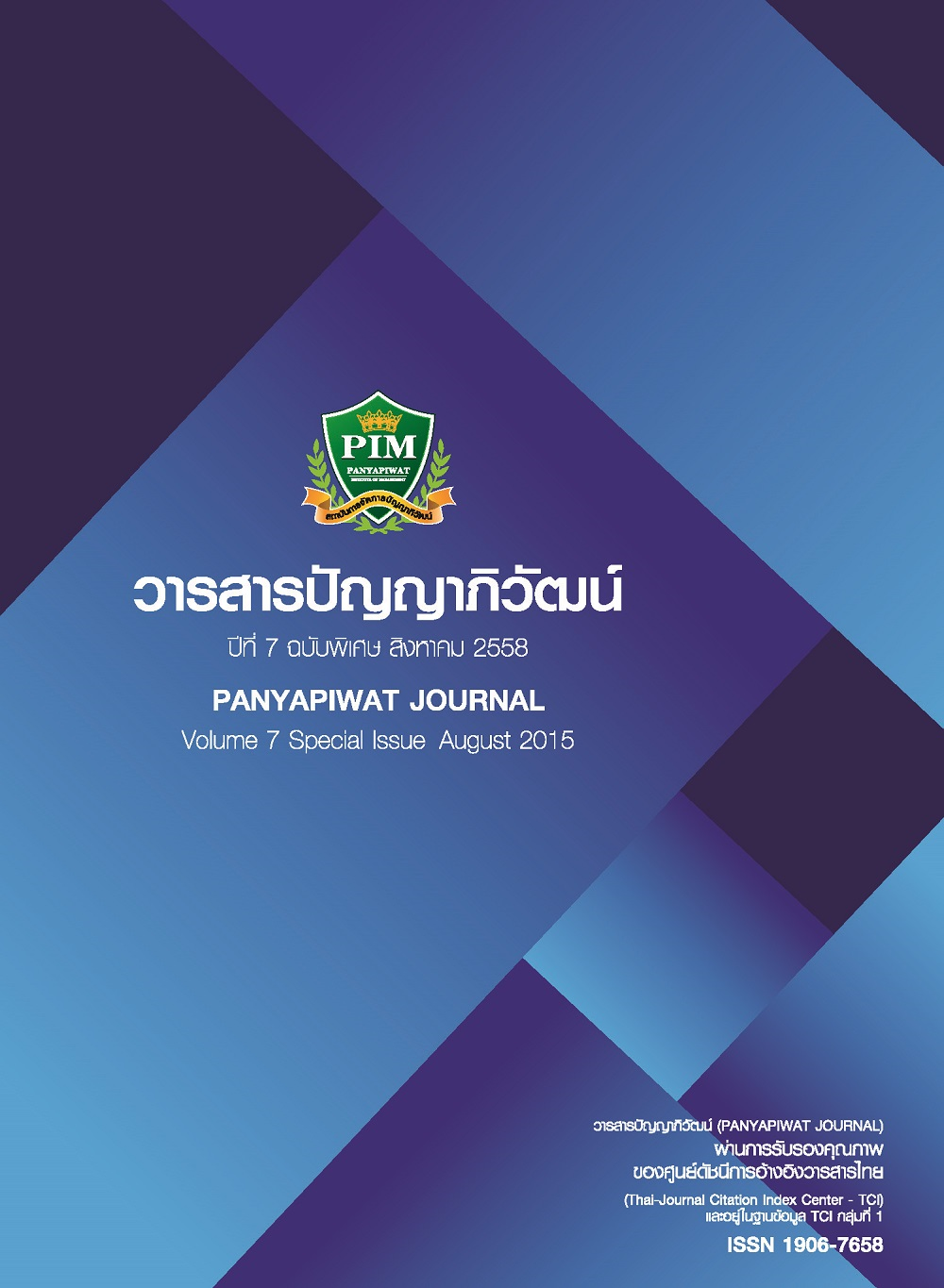จุดประกาย “แบรนด์นายจ้าง (Employer Brand)” เครื่องมือดึงดูดและรักษาทรัพยากรมนุษย์
Main Article Content
บทคัดย่อ
แนวคิดทางการตลาด (Marketing Concept) เริ่มเข้ามามีบทบาทส่งผลให้การบริหารจัดการองค์การมากขึ้น โดยเฉพาะการจัดการทรัพยากรมนุษย์ (Human Resource Management) ในการใช้แบรนด์นายจ้าง (Employer Brand) เพื่อการดึงดูดบุคลากร และรักษาทรัพยากรมนุษย์ในองค์การที่มีศักยภาพและมีความสามารถให้เข้ามาทำงานในองค์การและอยู่กับองค์การไปนานๆ จะมีผลกระทบต่อเนื่องให้บุคลากรมีความมุ่งมั่นและผูกพันกับการทำงาน รู้สึกพึงพอใจในงานที่รับผิดชอบ และส่งผลต่อเนื่องไปสู่การให้บริการที่มีคุณภาพ นอกจากนี้ยังส่งเสริมให้พนักงานมีความผูกพันต่อองค์การและมีผลการปฏิบัติงานที่ดีขึ้น การสร้างแบรนด์นายจ้างที่ดีนั้นองค์การควรคำนึงกลยุทธ์ทั้งปัจจัยในภาพกว้างและภาพย่อย ซึ่งประกอบด้วย 1) ความมีชื่อเสียงภายนอก 2) การสื่อสารภายในองค์การ 3) ผู้นำระดับสูง 4) ค่านิยมและความรับผิดชอบต่อสังคม 5) ระบบการวัดผลภายในองค์การ 6) การสนับสนุนด้านบริการ 7) การสรรหาและการเข้ารับตำแหน่ง 8) การบริหารจัดการทีม 9) การประเมินผลการปฏบัติงาน 10) การเรียนรู้และการพัฒนา 11) ค่าตอบแทนและการยอมรับ และ 12) สภาพแวดล้อมในการทำงาน ดังนั้นองค์การควรต้องสร้างแบรนด์นายจ้าง (Employer Brand) ที่มีความเหมาะสมและสอดคล้องกับความต้องการ วิสัยทัศน์ พันธกิจ และเป้าหมายขององค์การ เพื่อองค์การจะสามารถดึงดูดสรรหาบุคลากรจากภายนอกและรักษาพนักงานภายในที่มีศักยภาพให้อยู่กับองค์การนานที่สุด รวมถึงพาองค์การไปสู่ความได้เปรียบทางการแข่งขันในอนาคต
The marketing concept has more importance role and affected in Human Resource Management (HR). HR used employer brand to attract and retain employees and candidates who have potential and capability moved to the organization and lived for a long time. Employer brand have affected the staff's efforts, engaged work and job satisfaction through quality of products and service. In addition, employer brand have promoted employees have good performance. Strength employer branding, the employer should determine the strategy that consists of the following factors; 1) external reputation 2) internal communication 3) senior leadership 4) value and CSR 5) internal measurement systems 6) service support 7) recruitment and induction 8) team management 9) performance appraisal 10) learning and development 11) reward and recognition 12) working environment. The organization should create employer branding that aligned with the vision, mission, goals and strategies. Furthermore employer branding have taken organization in competitive advantage.
Article Details
“ข้าพเจ้าและผู้เขียนร่วม (ถ้ามี) ขอรับรองว่า บทความที่เสนอมานี้ยังไม่เคยได้รับการตีพิมพ์และไม่ได้อยู่ระหว่างกระบวนการพิจารณาลงตีพิมพ์ในวารสารหรือแหล่งเผยแพร่อื่นใด ข้าพเจ้าและผู้เขียนร่วมยอมรับหลักเกณฑ์การพิจารณาต้นฉบับ ทั้งยินยอมให้กองบรรณาธิการมีสิทธิ์พิจารณาและตรวจแก้ต้นฉบับได้ตามที่เห็นสมควร พร้อมนี้ขอมอบลิขสิทธิ์บทความที่ได้รับการตีพิมพ์ให้แก่สถาบันการจัดการปัญญาภิวัฒน์หากมีการฟ้องร้องเรื่องการละเมิดลิขสิทธิ์เกี่ยวกับภาพ กราฟ ข้อความส่วนใดส่วนหนึ่งและ/หรือข้อคิดเห็นที่ปรากฏในบทความข้าพเจ้าและผู้เขียนร่วมยินยอมรับผิดชอบแต่เพียงฝ่ายเดียว”
References
Ambler, T. & Barrow, S. (1996). The Employer Brand. Journal of Brand Management, 4, 185-206.
Backhaus, K. & Tikoo, S. (2004), Conceptualizing and researching employer branding. Career Development International, 9(5), 501-517.
Barrow, S. & Mosley, R. (2005). The Employer Brand: Bringing the Best of Brand Management to People at Work. Chichester: John Wiley & Sons.
Botha, A., Bussin, M. & Swardt de, L. (2011). An employer brand predictive model for talent attraction and retention. SA Journal of Human Resource Management, 9(1).
Cable, D. M. & Turban, D. B. (2003), The value of organizational image in the recruitment context: a brand equity perspective. Journal of Applied Social Psychology, 33(11), 2244-2266.
CIPD. (2007). Chartered Institute of Professional Development. Retrieved March 10, 2015, from http://www.cipd.co.uk
Edwards, M. R. (2010). An integrative review of employer branding and OB theory. Personnel Review, 39(1), 5-23.
Figurska, I. & Matuska, E. (2013). Employer Branding as a Human Resources Management Strategy. Human Resources Management & Ergonomics, 7(2), 35-51.
Freeman, C. & Knox, S. (2006). Measuring and managing employer brand image in the service industry. Journal of Marketing Management, 22(7-8), 695-716.
Hewitt Associates. (2003). Best Employers in Asia: Regional results—2003. Retrieved March 10, 2015, from http://was4.hewitt.com/bestemployers/asia/english /results2003/index.htm
Mandhanya, Y. & Shah, M. (2010).Employer branding- a tool for talent management. Global Management Review, 4(2), 43.
Martin, G. & Hetrick, S. (2006). Corporate Reputation Branding Management. A Strategic Approach to HR. Oxford: Butterworth-Heinemann.
Martin, G., Beaumont, P., Doig, R. & Pate, J. (2005). Branding: A new performance discourse for HR?. European Management Journal, 23(1), 76-88.
Martin, A., MacTaggart, D. & Bowden, J. (2006), “The barriers to recruitment and retention of supervisors / managers in the Scottish tourism industry”. International Journal of Contemporary Hospitality Management, 18(5), 380-397.
Menor, J. H. (2010). 10 Strategic Tips for Employee Retention. 2010. The Recruiters Lounge. Retrieved March 10, 2015, from http://www.therecruiterslounge.com/2010/08/17/10-strategic-tips-for-employee-retention
Minchington, B. (2006). Measuring Employer Brand Effectiveness. Retrieved March 10, 2015, from http://www.pageuppeople.co.uk/Newsletter
Rosethorn, H. (2009). The employer brand. Keeping faith with the deal. Farnham: Gower.
SHRM. (2008). The Employer Brand: A Strategic Tool to Attract, Recruit and Retain Talent. Society for Human Resources Management, April/June 2008.
Sullivan, J. (2004). “Eight elements of a successful employment brand”, ER Daily, 23 February, Retrieved March 10, 2015, from www.erexchange.com/articles/db/52CB45FDADFAA4CD2BBC366659E26892A
Tam, M., Korczynski, M. & Frenkel, S. (2005). “Organizational and occupational commitment: knowledge workers in large organizations”, in Little, S. & Ray, T. (Eds.), Managing Knowledge. London: Sage.
Watson Wyatt. (2005). Maximizing the return on your human capital investment. Human capital index report. Retrieved May 10, 2015, from http://www.watsonwyatt.com
Xiang, X., Zhan, Z. & Yanling, L. (2012). The Impact of Employer Brand on Corporate Financial Performance. Singapore: IACSIT Press.

